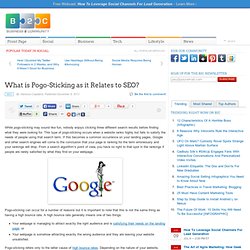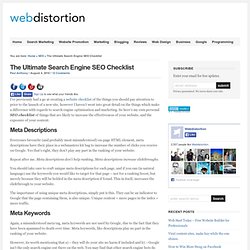

SEO friendly URLs: myth and fact. There's a lot said about SEO friendly URLs - the idea that having keywords in your URL will help you rank well for those keywords.

I list several sites saying this below ... The bad news: SEO-friendly URLs are largely a myth. They don't make that much difference. The good news: it's still worth putting keywords in your URLs. Confused? Google doesn't take much account of keywords in URLs Intuitively, you might think google would want to take account of what a URL has in it. However, the drawback is that lots of URLs aren't SEO friendly - EG those of CMSes that don't generate them. How to Analyze Google Analytics (not provided) Data - YouMoz. It has been over three months since Google announced the (not provided) update that would protect privacy hide search referral keywords for organic traffic.

Since (not provided) results only show up while logged in to Google, the increase to over 60 million Google plus users – and estimates of 400 million by the end of 2012 – indicates that the problem of search referral data is not going away anytime soon. While Google’s own Matt Cutts estimated that “even at full roll-out, this would still be in the single-digit percentages of all Google searches on google.com,” SEOs and web marketers are seeing that percentage grow steadily past initial estimates.
While this might hold true when looking at total Google searches, likely it is not true for you or your clients. If you don’t like this kind of uncertainty in a career, then maybe SEO isn’t for you. However, if you love a challenge and finding creative ways to overcome obstacles, read on. Which (not provided) results are branded? Conclusion: What is Pogo-Sticking as it Relates to SEO? While pogo-sticking may sound like fun, nobody enjoys clicking three different search results before finding what they were looking for.

This type of pogo-sticking occurs when a website ranks highly but fails to satisfy the needs of people using that search term. If this becomes a common occurrence on your landing pages, Google and other search engines will come to the conclusion that your page is ranking for the term erroneously and your rankings will drop. From a search algorithm’s point of view, you have no right to that spot in the rankings if people are rarely satisfied by what they find on your webpage. Pogo-sticking can occur for a number of reasons but it is important to note that this is not the same thing as having a high bounce rate. A high bounce rate generally means one of two things: Pogo-sticking refers only to the latter cause of high bounce rates. Common Causes Related Resources from B2C» Free Webcast: How To Leverage Social Channels For Lead Generation Quick Tips. Google Panda 4, and blocking your CSS & JS. A month ago Google introduced its Panda 4.0 update.

Over the last few weeks we’ve been able to “fix” a couple of sites that got hit in it. These sites both lost more than 50% of their search traffic in that update. When they returned, their previous position in the search results came back. Sounds too good to be true, right? Read on. Last week Peter – an old industry friend who runs a company called BigSpark – came by the Yoast office.
Notice the initial dip, then the return and the second dip, leaving them at 1/3rd of the SEO visibility they were “used to”. Fetch as Google’s relation to Google Panda In Google Webmaster Tools, Google recently introduced a new feature on the fetch as Google page: fetch and render. Even for fans of minimalism, this is too much. Now, iPhoned makes money from ads.
Google runs so called page layout algorithms to determine how many ads you have. Remarkable resurrection The result was surprising, more so even because of the speed with which it worked. The Ultimate Search Engine SEO Checklist. I’ve previously had a go at creating a website checklist of the things you should pay attention to prior to the launch of a new site, however I haven’t went into great detail on the things which make a difference with regards to search engine optimisation and marketing.

So here’s my own personal SEO checklist of things that are likely to increase the effectiveness of your website, and the exposure of your content. Meta Descriptions Everyones favourite (and probably most misunderstood) on-page HTML element, meta descriptions have their place in a webmasters kit bag to increase the number of clicks you receive on Google. Yes that’s right, they don’t play any part in the ranking of your website.
Repeat after me. You should take care to craft unique meta descriptions for each page, and if you can (in natural language) use the keywords you would like to target for that page – not for a ranking boost, but merely because they will be bolded in the meta description if found. Search Engine Ranking Factors. Google's SEO Starter Guide. The Periodic Table Of SEO Success Factors.